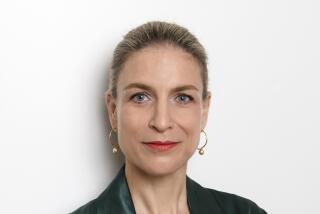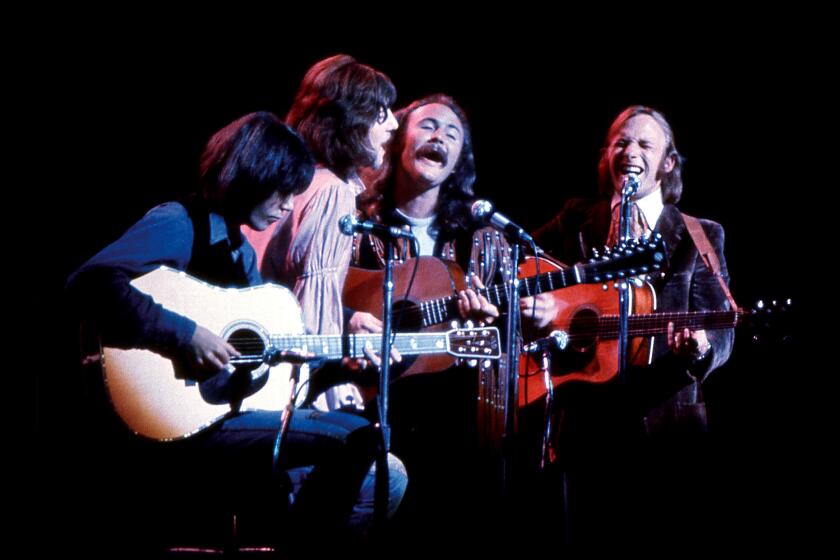LACMA Chief to Add Role of Art Director
- Share via
The Los Angeles County Museum of Art announced Wednesday that it is expanding the role of President and Chief Executive Andrea L. Rich to include the duties of departing Director Graham W.J. Beal, who was second in command and oversaw the exhibitions and other art programs.
The decision, approved at an afternoon meeting of the board of trustees, makes LACMA the only major art museum in the country without an art expert at its helm. The action sparked fears that art would become secondary to box office at the largest encyclopedic art museum in the western United States.
Rich, who has no formal art training, has run the museum for four years and is credited with revitalizing the Wilshire Boulevard institution by expanding its facilities. With Beal, she brought in popular shows of works by Van Gogh, Picasso and Diego Rivera. But when she was hired, it was with the understanding that an art specialist director would supervise the museum’s exhibitions and collections. Beal, who has served in that capacity for the past three years, has been selected to head the Detroit Institute of Arts; his appointment is expected to receive official approval in Detroit today.
Rich’s expanded position is part of a restructuring plan that dissolves a controversial system of bifurcated leadership, but it could intensify scrutiny of the museum’s governance. LACMA has already been criticized in art circles since Rich’s appointment in 1995 because she ranked higher than Beal, who led the Joslyn Art Museum in Omaha before coming to Los Angeles.
Formerly executive vice chancellor of UCLA, Rich, 56, makes no pretense of being an art expert, and in taking on her new role she has promoted two veteran curators--Nancy Thomas, curator of ancient and Islamic art, and Robert Sobieszek, curator of photography--as deputy directors to help supervise the museum’s art programming. Nonetheless, the symbolism of an administrator assuming the role of director is unsettling to traditionalists who believe that leaders of art museums should be well grounded in art history.
“Every decision in a museum--whether it has to do with what you merchandise, the nature of your food service or how you fund-raise--comes back to the central artistic mission,” said Edmund P. Pillsbury, until recently director of the Kimbell Art Museum in Fort Worth, expressing a view common among art museum directors and curators. “It’s a question of priorities and budget. How can somebody who is either trained in business or trained in a field unrelated to art, whether it be literature or the humanities, come in and make those decisions?”
Not All in Museum Field Are Critical
Not everyone in the museum field takes a dim view of LACMA’s restructuring plan, however.
Stephen Weil, emeritus senior scholar at the Smithsonian Institution’s Center for Museum Studies in Washington and America’s leading museum theorist, contends that the evolution of LACMA’s administration is simply a harbinger of changing times.
“I think the components of the whole cultural sector--education, the performing arts and the visual arts--are all converging,” Weil said. “These organizations are losing the sharp boundaries they used to have, so having a university administrator running a museum is a lot less of an alien thought than it would have been 30 years ago.
“It might be threatening and shocking if Andrea Rich came from the for-profit sector,” he said. “But we know museums today are not about collections of art; museums are about public service in the cultural field. That’s what the university is also about. There’s a lot of commonality among these institutions, which is that they are all ultimately in a public service business.”
Declining to criticize their colleagues on the record, wary museum directors and curators point to other museums that have tried and rejected systems of dual leadership, in which an art-trained director is subservient to a paid president. For example, art specialists now rule the Metropolitan Museum of Art in New York and the Philadelphia Museum of Art, two major institutions that have experimented with administrative/artistic partnerships in recent years.
At LACMA, Rich and the trustees contend that their newly adopted plan is the most efficient way to forge ahead and make the best use of existing staff.
Not having an art-trained director is “new territory, no question,” said Wally Weisman, chairman of the board at LACMA. “But I am absolutely confident that Andrea is the kind of leader who will ensure that the progress she envisions is going to happen.”
Rich said she worked with the staff and trustees to revise the museum’s chain of command over the past two months, after Beal notified her that he was the leading candidate for the directorship at the Detroit Institute of Arts and had decided to move there. Looking for an art professional to fill his position was less crucial than maintaining the museum on a steady course, she said.
Under Rich, the museum has had a boom in membership--from 60,000 to 118,000--and a financial windfall as a result of the recent blockbuster “Van Gogh’s Van Goghs: Masterpieces From the Van Gogh Museum, Amsterdam.” Sources close to the museum say the phenomenally popular exhibition netted $7 million for LACMA. Rich will only say that “it netted a lot of money.” The museum also opened a new wing in the nearby renovated May Co. building, where the Van Gogh exhibit was held, and upgraded the parklands around the museum’s facilities.
“The most important thing to me is that LACMA not lose the momentum it has,” Rich said. “We have been engaged in very serious, in-depth planning--not just for the museum in general, but also within the curatorial areas--on everything from positions that need to be filled and have been funded as high-priority items, to major acquisitions that are right on the brink of happening, to very complicated exhibitions that we are putting together. And, most important, we need to get the I’s dotted and the Ts crossed to begin a major capital campaign.
“The board, the executive committee and I agreed that we should not stop that while we conduct one of those long searches that go on for museum directors. There are simply more institutions that need leadership than there are candidates from the traditional pool to lead them.”
Rich has redeployed some members of the staff to give her “more time to focus on the art part,” she said. “When I came in, everything needed work--everything from computers to janitors to the physical facility to the financial structure. I’ve spent four years fixing that. It’s in pretty good shape, and some really outstanding people have emerged. I can give greater administrative authority to people who have proven themselves so I can focus and work more closely with the curators,” she said.
When Rich took charge of the museum in 1995, she faced significant challenges. LACMA flourished during the 1980s but languished after Director Earl A. Powell ended a 12-year tenure in 1992 to head the National Gallery of Art in Washington. Los Angeles County reduced its support of the museum from a high of $17.8 million in 1991 to as low as $11.6 million in 1993. Michael Shapiro, a former curator at the St. Louis Museum of Art, succeeded Powell at LACMA in 1992 but resigned under duress less than a year later.
After a two-year search failed to produce an art specialist with administrative experience who was willing to take the director’s job, the museum’s board split the top position. Rich was hired as president. A year later, Beal was appointed director and executive vice president.
“It was hard getting going,” Rich said, “but the board is extremely supportive now. Everyone is rowing in one direction.”
The new administrative structure will stay in place as long as it works, she said. “Maybe other institutions wouldn’t have benefited from someone like me, but LACMA needed me,” Rich said. “I found it a challenge, and I have greatly enjoyed it. I am enormously proud of this institution and the people here, both on the board and the staff, who have stepped up to the plate, and have done things a little unconventionally perhaps--but with dignity and pride and professionalism.
“We’re just cooking. And we’ve done it not by a fluke or smoke and mirrors or just glitzy things; we’ve done it through hugely difficult work. We would be in great shape if ‘Van Gogh’ had never come here. That was the icing on the cake.”
More to Read
The biggest entertainment stories
Get our big stories about Hollywood, film, television, music, arts, culture and more right in your inbox as soon as they publish.
You may occasionally receive promotional content from the Los Angeles Times.










